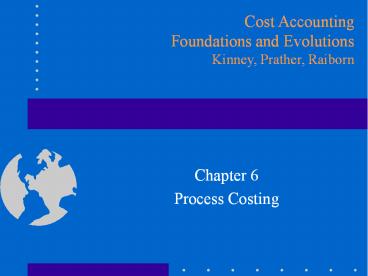Process Costing - PowerPoint PPT Presentation
1 / 19
Title:
Process Costing
Description:
Cost Accounting Foundations and Evolutions Kinney, Prather, Raiborn Chapter 6 Process Costing Job Order vs. Process Costing Job Order Assign costs to job and then to ... – PowerPoint PPT presentation
Number of Views:234
Avg rating:3.0/5.0
Title: Process Costing
1
Cost Accounting Foundations and
Evolutions Kinney, Prather, Raiborn
Chapter 6 Process Costing
2
Learning Objectives (1 of 3)
- Contrast process costing and job order costing
- Explain why equivalent units of production are
used in process costing - Calculate equivalent units of production, unit
costs, and inventory values using weighted
average method of process costing
3
Learning Objectives (2 of 3)
- Compute equivalent units of production, unit
costs, and inventory values using FIFO method of
process costing - Explain how standard costs are used in a process
costing system - Explain why a company would use a hybrid costing
system
4
Learning Objectives (3 of 3)
- (Appendix 1) Explain the alternative methods used
to calculate equivalent units of production - (Appendix 2) Describe how normal and abnormal
spoilage losses are treated in an EUP schedule
5
Job Order vs. Process Costing
- Job Order
- Assign costs to job and then to units within the
job
- Process Costing
- Using an averaging technique, assign costs
directly to units produced during the period
6
Process Costing
- The Numerator - Production Costs
- Accumulate costs by department
- Accumulate costs by product
- Direct material from material requisitions
- Direct labor from time sheets and wage rates
- Overhead
- Actual
- Predetermined application rates
Unit Cost Production Costs
Production Quantity
7
Process Costing
- Production Costs
- Direct material from material requisitions
- Direct labor from time sheets and wage rates
- Overhead
- Actual
- Predetermined application rates
8
Process Costing
- The Denominator - Units Produced
- Complicated by work in process
- Units started last period and completed this
period - Units started this period and not completed
- Convert partially completed units to equivalent
whole units
Unit Cost Production Costs
Production Quantity
9
Equivalent Units of Production (EUP)
- Approximation of the number of whole units of
output that could have been produced from the
actual effort expended - Includes units
- started last period and finished this period
- started and finished this period
- started this period and not finished
- Assumes FIFO physical flow through the production
department
10
Two Process Costing Methods
- Weighted Average Method
- combines
- beginning work in process
- current period production
- FIFO Method
- separates
- beginning work in process
- current period production
11
Process Costing Methods
- Weighted Average
- Beginning WIP 100
- Started and finished 100
- Ending WIP completed
- FIFO
- Beginning WIP completed
- Started and finished 100
- Ending WIP completed
12
Process Costing
- Direct material
- added at the beginning, during, and/or at the end
of process - Direct labor
- added throughout the process
- Overhead
- added throughout the process
- based on direct labor
- based on other, multiple cost drivers
13
Process Costing Steps
- Units to account for
- Units accounted for
- Determine equivalent units
- Costs to account for
- Compute cost per equivalent unit
- Assign costs to inventories
14
Cost of Production Report
Name of Department
3
for the period ---
2
1
Production Data Units to account for Units
accounted for EUP for each cost Cost Data Costs
to account for Cost per EUP Cost
Assignment Transferred Out Ending Work In
Process Inventory
4
5
6
15
Process Costing with Standard Costs
- Simplify costing process
- Eliminate periodic cost recomputations
- Same as FIFO computations
- emphasize current period costs and production
- Inventories are stated at standard cost
- Variances are calculated for material, labor, and
overhead
16
Process Costing with Standard Costs
- Assigns a normal production cost to the
equivalent units of output each period - Allows managers to quickly recognize and
investigate significant deviations from expected
production costs - Allows benchmarking with other firms
17
Hybrid Costing Systems
- Characteristics of job order and process costing
systems - Various product lines
- different direct material - job order costing
- different direct labor job order costing
- same process - process costing
- Hybrid costing used for furniture, clothing, jam
18
Appendix 2 - Spoilage
Normal Spoilage
Abnormal Spoilage
Loss in all ending inventory and transferred out
units on an EUP basis
Continuous Loss
Period expense in EUP
Loss in all units past inspection point in ending
inventory and transferred out on an EUP basis
Discrete Loss
Period expense in EUP
19
Questions
- What is an equivalent unit of production?
- What is the difference between the weighted
average and FIFO methods of calculating
equivalent units? - Why would a company use a hybrid costing system?































